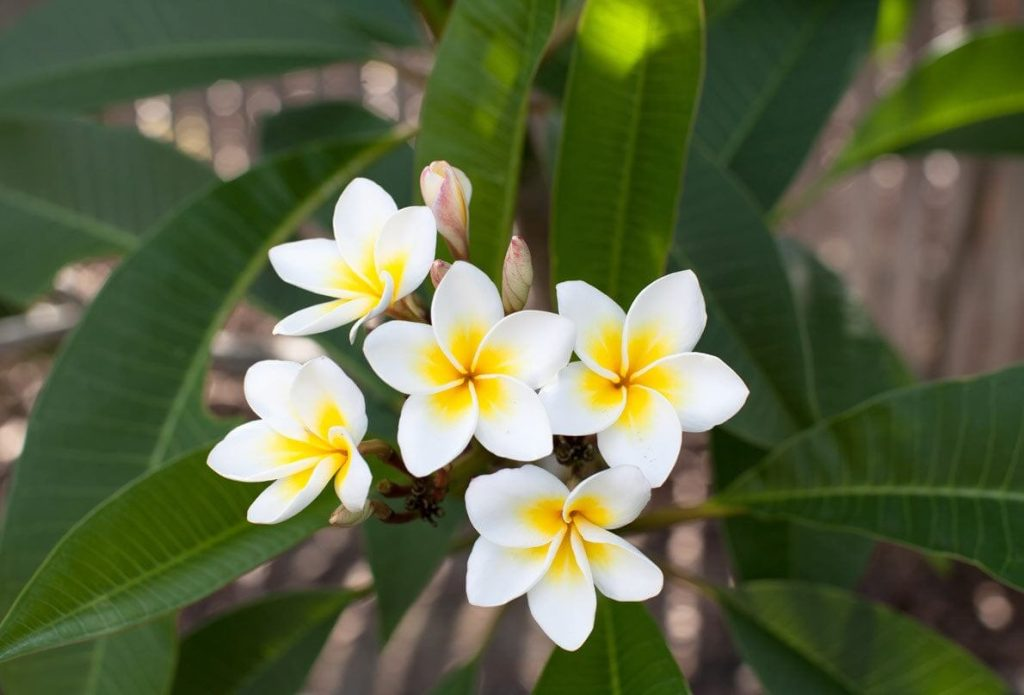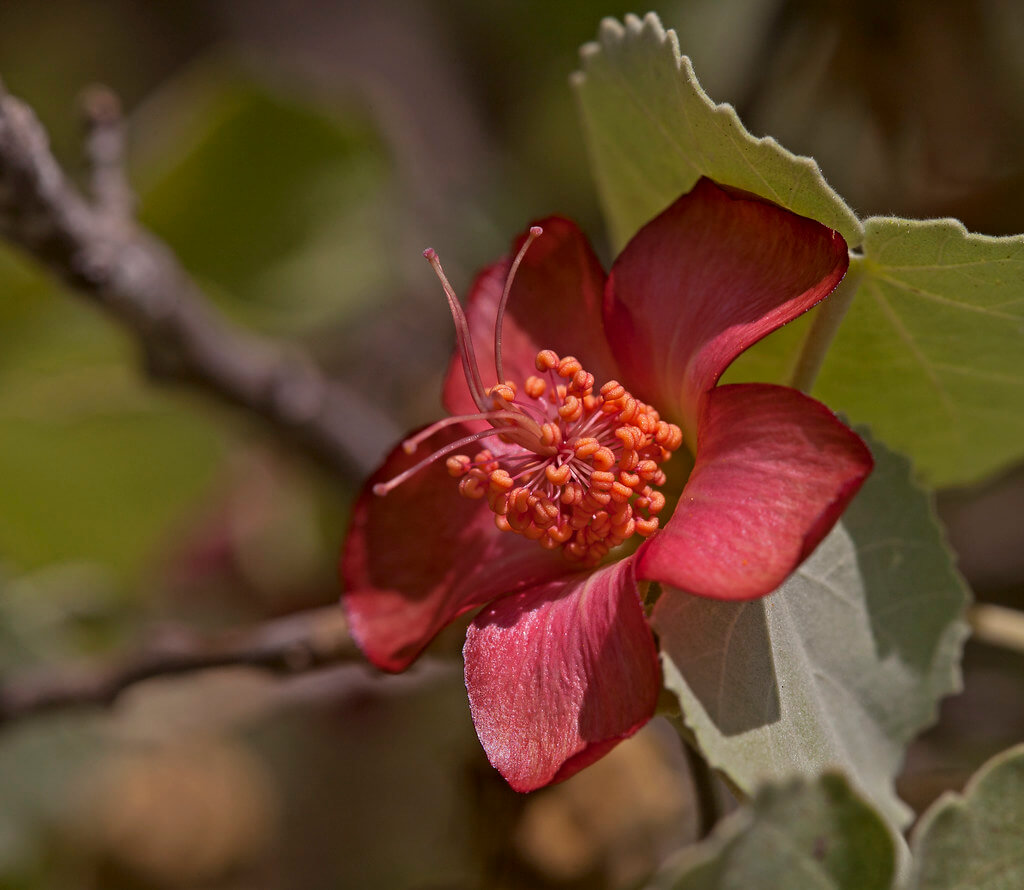Journeying to Hawaii and overlooking its enchanting tropical flora is akin to savoring a cake devoid of its crowning icing. With a floristic uniqueness, over 90% of Hawaiian plants are endemic, found exclusively in this archipelago, presenting a mesmerizing spectacle of hues and aromas.
Plumeria Bloom

The Plumeria stands as a quintessential spectacle in Hawaii. This mesmerizing flora, donning a spectrum from alabaster to shades of yellow, cerise, and violet, is beloved for its ambrosial fragrance and vivid appearance. Adorning oneself with a Plumeria lei is to envelop in an aura of captivating scent, encapsulating the essence of aloha, rendering it a treasured token in Hawaiian culture.
Cultivating Plumeria beyond Hawaiian shores is feasible; with apt nurture, they thrive even on the continental U.S., Flaunting a palette from crimson to ivory and even vibrant tangerine.
Embark on a journey to witness these splendid Hawaiian flora firsthand!
Hawaiian Hibiscus Spectacle

Behold the Hawaiian Hibiscus, a vision of tropical splendor. Among Hawaii’s floral treasures, it shines prominently. This genus embraces seven species, with the golden hibiscus acclaimed as Hawaii’s floral emblem. These species burgeoned from four distinct migration phenomena. Though the alien Chinese hibiscus finds favor in cultivation across Hawaii, the indigenous Hibiscus arnottianus occasionally graces gardens.
Regrettably, the golden hibiscus faces the peril of extinction, with fauna such as goats and swine constituting threats. In 1988, it was honored as Hawaii’s state flower. The Hibiscus brackenridgei also represents the unique botanical heritage of Hawaii.
The golden hibiscus flourishes across all Hawaiian Isles save for Niʻihau and Kahoʻolawe, manifesting in forms from diminutive shrubs to towering arbors.
A Hawaiian sojourn remains incomplete sans witnessing this flora. Amidst a plethora of beauties, the Hawaiian Hibiscus claims its pride of place!
Bird of Paradise: A Tropical Marvel

The Bird of Paradise, an emblem of splendor, joy, and utopia, is a must-encounter flora in Hawaii. Though an alien, it has ingrained itself into the Hawaiian ethos and landscape. Thriving wildly, it’s affectionately termed “Little Globe” in local parlance. Originating from Madagascar, this exotic flora, inclusive of the majestic giant bird-of-paradise (Strelitzia nicolai), adorns Hawaii in diverse species.
Its avian semblance not only enchants visually but also piques scientific curiosity, spurring advancements in optics, materials science, and engineering. For enthusiasts desiring a fragment of this marvel, Hawaiian bird of paradise plants are procurable locally.
This flora adds a dash of bold chromaticity to Hawaii’s tropical floral tapestry. The Bird of Paradise is indeed among the top quintessential Hawaiian flora to behold.
Pikake

Pikake, known otherwise as Arabian or Indian jasmine (Jasminum sambac), hails from India. This vining shrub, with spherical foliage and distinctive alabaster florets, is cultivated across nations like India, Thailand, and the Philippines for its fragrant blossoms, utilized in perfumery and tea flavoring. Its aroma is sublime, particularly when woven into a pikake lei, with its essence distilled into perfumes and oils.
In the Philippines, where it’s celebrated as the national bloom, it’s dubbed “sampaguita.” Beyond its olfactory allure, pikake’s scent is reputed to elevate self-assurance, alleviate trepidation, and serve as an aphrodisiac. As a hardy plant, pikake is an exquisite, drought-tolerant addition to Hawaiian gardens.
Ohia Lehua

The Ohia Lehua (Metrosideros polymorpha), a cornerstone of Hawaiian culture and ecology, dominates as the principal native tree, comprising 80% of Hawaii’s indigenous forests. Belonging to the Myrtaceae family, it manifests in diverse guises, from humble shrub to majestic tree, occasionally soaring to heights of 82 feet. Remarkably, the Ohia Lehua prospers post-volcanic eruptions, pioneering new lava flows and emerging directly from lava rock. Its blooms, a dense assembly of stamens, bewitch in shades from incandescent red to yellow.
Its cultural and ecological significance is profound, often featuring in Hawaiian moʻolelo (lore). A poignant narrative recounts the romance of ʻŌhiʻa and Lehua, with ʻŌhiʻa metamorphosed into a tree by a jealous Pele, the volcano deity, and Lehua, in her sorrow, transformed into the tree’s blossom.
Historically, its wood was fashioned into implements, and its foliage brewed into medicinal concoctions. It underpins a biodiverse ecosystem, providing habitat for endemic insects and rare tree snails.
Yet, the Ohia Lehua is imperiled by the rapid Ohia Death, a fungal malady threatening its Hawaiian presence.
Beholding an Ohia Lehua during your Hawaiian voyage will undoubtedly enhance the memorability of your visit!
Naupaka

The naupaka (Scaevola sericea), with its half blooms and a tapestry of legend, holds a unique position among Hawaiian flora. Prospering both seaside and mountainous terrains, it bifurcates into naupaka Kahakai, the coastal dweller, and naupaka Kauihiwa, the mountain inhabitant.
While the coastal naupaka thrives along various tropical shores of the Pacific, the mountainous variant is exclusive to Hawaii. The legend narrates a tale of star-crossed lovers, naupaka and Kauihiwa, leading to the plant’s bifurcated blossoms, symbolizing their eternal separation and undying love.
This flora not only embellishes Hawaiian landscapes but also fortifies them, serving as a natural barricade against coastal erosion and habitat for native fauna.
A sojourn to Hawaii offers an exclusive opportunity to bask in the glory of these unique and captivating flora, each weaving its own narrative within the rich tapestry of Hawaiian culture and biodiversity.
Heliconia

Upon traversing the verdant realms of Hawaii, one is compelled to witness the Heliconia, a botanical marvel that arrests the gaze with its flamboyant vermilion hues.
This genus, indigenous to the tropical Americas, has stamped its exuberant presence across Hawaiian landscapes and swathes of the western Pacific.
Distinguished by their resplendent floral bracts, which parade a spectrum of red, orange, yellow, and green, these flora also present expansive foliage tinged with possible copper hues, occasionally adorned by ivory or pink streaks at their cores. Hummingbirds, lured by the dazzling pigments and nectar, are customary pollinators of these blooms, which predominantly prosper amidst the pluvial season of Hawaii, adorning rainforests and humid tropic environments.
Valued immensely for their decorative prowess within tropical arboretums, among the roughly 200 species of Heliconia, the majority originate from the neotropic zones. It is of note that certain species are deemed vulnerable by the IUCN Red List.
Thriving in balmy, humid locales, these specimens wane under the chill or dry conditions. The fruit, upon reaching maturity, manifests as a drupe, harboring genuine seeds within its sturdy core. In sum, Heliconias bestow upon the Hawaiian landscapes a verdure and vibrancy unparalleled.
Hence, it behooves one to include Heliconia in their itinerary of floral wonders as they delve into the captivating flora of Hawaii.
Hinahina: A Glimpse into Hawaii’s Botanical Heritage

In the heartland of the Pacific, the Hinahina, or beach heliotrope (Heliotropium anomalum), emerges as a quintessential native flora, sprawling across the Hawaiian archipelago. This shrub, modest in stature, is adorned with silvery-gray foliage, its texture owed to a delicate veil of fine hairs, a testament to its adaptation to the coastal margins it calls home. It thrives, undeterred by saline mists and granular soils, embodying the essence of resilience and beauty on the fringes of Hawaii’s islands.
The Hinahina is not merely a botanical specimen but a cultural cornerstone, woven into the fabric of Hawaiian traditions. Its ecological prowess is undeniable, playing a vital role in the restoration of coastal ecosystems and the battle against the encroachment of erosion. Its form, often conflated with succulents due to its visage, holds the honor of being Kahoʻolawe’s official emblem—a bloom of special stature within the Hawaiian floral kingdom.
Koʻoloaʻula: Sentinel of Kahoʻolawe’s Flora

Endemic to the sacred soils of Kahoʻolawe, the Koʻoloaʻula (Argyroxiphium kauense) stands as a paragon of the silversword alliance, its lineage intertwined with the sunflower family. This flora, with its distinctive silver-foliaged rosette and towering stalks crowned with yellow blossoms, narrates a tale of survival and rarity, reaching skywards up to six feet. Yet, it teeters on the brink of oblivion, besieged by habitat degradation and the relentless advance of invasive species. Its preservation is championed by custodians like the Kahoʻolawe Island Reserve Commission, ensuring its legacy within the sanctified realms of Hawaiian culture and ecology.
Anthurium: Hawaii’s Floricultural Jewel

Introduced to Hawaiian soil in 1889 by Samuel Mills Damon, the Anthurium, with its origins in the South American rainforests, has flourished, particularly the vibrant Obake hybrids, which embarked on their genetic odyssey in the early 1930s. Nestled within Hawaii’s Puna region, known for its humid embrace, these hybrids have ascended to the zenith of the floriculture industry, celebrated for their substantial blossoms. The Anthurium, with roots in foreign lands, has become an integral thread in the tapestry of Hawaii’s botanical heritage, merging tradition with the pioneering spirit of hybridization.
Nau or Napu: Fragrance of the Hawaiian Isles

The Hawaiian Gardenia (nau or napu), a gem native to Hawaii’s emerald isles, stands majestically, its branches reaching upwards to 16 feet, clad in dark, glossy foliage. Its blossoms, a symphony of fragrance, are a spectacle of solitary white flowers that coalesce into a tubular form. Once a ubiquitous sight across the Hawaiian chain, it now clings to existence in the tropical dry forests of select islands, a poignant reminder of nature’s fragility. Enshrined in Hawaiian culture, its ornamental grace is a beacon for conservation efforts, a symbol of beauty teetering on the edge of eternity.
Uki Uki: The Hawaiian Lily’s Lyrical Bloom

The Hawaiian Lily, or Uki Uki, weaves its green, sword-like leaves and clusters of blue-purple flowers into the fabric of Hawaii’s diverse ecosystems, from mesic to wet forests. Its berries, once a staple of indigenous diets, and its leaves, integral to traditional crafts, highlight its cultural and ecological significance. Though not endangered, it faces challenges that underscore its importance in the natural and cultural landscape of Hawaii.
Pua Kala: A Testament to Hawaiian Flora

The Hawaiian Poppy, Pua Kala, with its vibrant yellow blooms and prickly demeanor, stands as a monument to Hawaii’s endemic flora. Belonging to the poppy family, it thrives from the coast to the uplands, weaving itself into the cultural tapestry of the islands. While it navigates the threats of modernity and invasive pressures, it remains a steadfast symbol of Hawaii’s botanical heritage.
The Hawaiian Red Cranesbill: A Beacon of Biodiversity

Exclusive to Maui’s volcanic landscapes, the Hawaiian Red Cranesbill (Geranium arboreum) showcases nature’s artistry with its unique floral architecture designed for avian pollinators. Its precarious existence, with fewer than 500 specimens remaining, highlights the urgent need for conservation amidst the challenges of habitat loss and invasive threats. Revered in local culture, it underscores the intricate bond between Hawaii’s biodiversity and its cultural identity, serving as a custodian of the islands’ ecological and cultural legacy.
Silver Geranium (Hinahina)

The Silver Geranium, colloquially christened Hinahina, stands as a unique flora species, exclusive to the Hawaiian archipelago, an emblem of terrestrial singularity. This diminutive shrub, aspiring to a stature of no more than three feet, is distinguished by its argentate foliage, a tapestry of delicate hairs, and its petite blossoms of ivory hue encircling a golden core.
Thriving across a spectrum of ecosystems, from arid woodlands to montane scrublands and even the lofty realms of alpine territories, Hinahina is celebrated not only for its aesthetic contribution to horticulture and ecological restoration endeavors but also holds a sacrosanct position within Hawaiian lore. In bygone eras, its foliage was a source of herbal remedies, concocted into infusions for gastrointestinal maladies or applied as cataplasms to alleviate dermal afflictions.
While presently not endangered in the throes of extinction, the existence of the Silver Geranium is imperiled by the encroachment of alien species and the looming specter of habitat degradation.
Thus, should fortune ferry you to the Hawaiian isles, the opportunity to behold this rare and bewitching flora should not be forsaken.